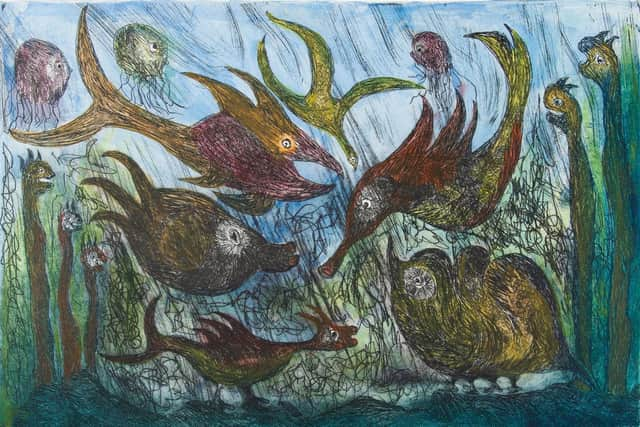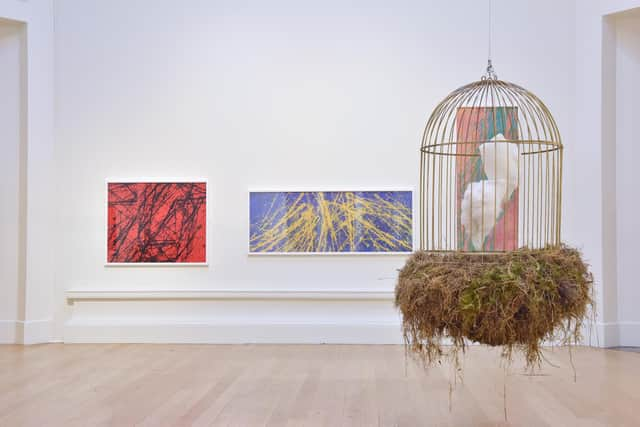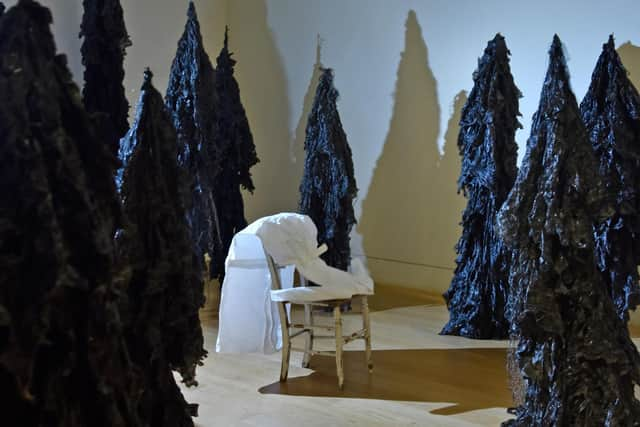Art reviews: Lotte Glob | New Contemporaries
Lotte Glob: Eriboll Creatures, Kilmorack Gallery, by Beauly *****
New Contemporaries 2023, Royal Scottish Academy, Edinburgh ****
Advertisement
Hide AdOnce, travelling in Denmark, my companion pointed to a small bump on the horizon. That, he said, is Denmark’s highest hill. Called Møllehøj, it is a towering 171 metres or 571 feet. Ceramicist Lotte Glob is Danish, and evidently she needed a more exciting landscape. Since 1968 she has lived and worked in the far north of Scotland, first in Durness, and for the last 20 years in an isolated croft where Ben Hope looks down on Loch Eriboll. Her ceramics are very much in and of this landscape. “Of” it because she incorporates elements of its complex geology (her studio is in the UNESCO nominated West Highland Geopark) to make her glazes and “in” it because she has the habit of placing her work, not only around her croft, but in the surrounding mountains too.


Born in 1944, age has not dimmed her creativity and her show of new work at the Kilmorack Gallery is crowded. It includes a lot of ceramic sculpture but also etchings. In both, the predominant iconography is marine: extraordinary sea creatures like those we glimpse in films and photographs from the deepest and darkest oceans. There are flat fishes with fearsome teeth and waving tubular creatures like the giant nematode worms discovered by volcanic vents thousands of metres underwater. All these fantastic creatures are rendered in forcefully stated sculptural forms. The glazes are rich and deep and so textured that the word “glaze” doesn’t really seem adequate. The integration of form and surface is the mark of great ceramics and we certainly see that here.
The marine phantasmagoria continues in her prints. It is as though weird creatures have crept out from the depths of Loch Eriboll to join her in her studio, or perhaps she has made concrete the monsters of our shared subconscious, but, doing so, has tamed them so they are no longer threatening. Miró, also a great ceramicist, did something very similar in ceramic walls where the monsters of the subconscious are tamed by innocence. In Glob’s work therefore, as we do in his, perhaps we see a fertile conjunction of Surrealism and the tradition of the Arts and Crafts movement, where ceramics were a key art form.
If Lotte Glob is 80 next year, the artists in the RSA New Contemporaries show, mostly in their early twenties, follow her at a distance of nearly 60 years. Each year, in principle, this show brings together a selection of the best artists from the the previous year’s graduating classes in the Scottish art schools. Because of the pandemic there was a blip, however. This show is selected from the graduating year of 2021. To catch up and reestablish the pattern, next year’s show may combine two years.
Perhaps that blip has meant pent up energy. Certainly there is lots of it apparent here. As you enter, a large red banner at the top of the stairs defiantly declares “Finish”. The artist is Bella Geldart. Here, setting the end at the beginning, consciously or otherwise, she echoes the opening of TS Eliot’s East Coker, second of the Four Quartets: “In my beginning is my end.” Other works in the show by her include a giant Olympic Torch.


The most impressive single work, however, is by Joise Ko. Dominating the central gallery, it is a huge figure of a black woman with yellow hair. She stands, arms akimbo, with a wide skirt spread out as though to enfold us, much like the traditional image of the Madonna of Mercy who shelters humanity under her outspread cloak. The Scottish Unicorn with a parking cone on its head prances in front of this enormous figure. The cone makes a link to the Duke of Wellington’s statue in Glasgow, always similarly crowned, and so the artist suggests that what she is proposing is a vivid alternative to the dominant, white-male iconography of public sculpture with its frequent subtext of slavery.
Advertisement
Hide AdKo was evidently inspired by Black Lives Matter. Jordyn Rachel Gardner is similarly engaged, but her cause is dairy cows and her crocheted works are called “uddercomforts”. A large, crocheted armchair and footstool seem to suggest an unlikely opportunity for bovine comfort.
Blythe Plenderleith has several intriguing objects including a broom leaning against the wall and somehow interwoven with the steps of a wooden ladder. Nearby, mysteriously and also by her, is a large, burnt wooden bed. Equally intriguing is Maya Rose Edwards’s sphere of interwoven barbed wire with sheep’s wool entangled in it and standing in a bed of straw. It is apparently an image of the rural and thus a vehicle for the artist’s idea that “queerness” and “rural” are words that inhabit the same lexical position. They are defined by what they are not. Lorna Phillips explores the rural in a quite different way. She progresses poetically from intricate small drawings of landscapes to simple earthenware pots. Their earthy material and curving forms, she suggests, echo the landscape.
Advertisement
Hide AdJasmine Forbes has a vigorous painting of cats with various feline sculptures alongside. The most remarkable of them is of a cat apparently scratching out its owner’s eyes. This savage image might seem to cut out any gazing, but she suggests nevertheless that somehow her cats are a vehicle for “exploring femininity and gaze.” Hooligan Sadikson is likewise rather contradictory as he complains that the exhibition is just “a fancy shop” making art into a mere commodity, but nevertheless exhibits three rather good abstract paintings. For some reason all his work is priced in multiples of 11. A group of black shrouded figures by Ruth Tait, a graduate of UHI in Orkney, commemorates 15 men lost in a blizzard as they went in search of food. This happened during the mini-ice age in the 17th century, when the islanders were starving. It is perhaps an oblique comment on the fragility of the islands, threatened by climate change.


In a very different mood, Julia Johnstone dresses up as a rather glamorous Taylor of Gloucester-style mouse, to be filmed parading through the streets of Glasgow. Jake Gatehouse’s Submerged Self-Portraits are an original and entertaining take on the photographic self-portrait. He sets up his huge plate camera by water, sets the timer and jumps in. The resulting photo is just of the splash. Submerged, he has disappeared.
With almost 50 artists showing, there is a great deal more to admire here, but among them I did think that Faye Eleanor Woods’s paintings were outstanding. On a folktale theme of women and pubs, the key work is a large painting entitled I have sold my soul for this pint and I have no regrets. A wild looking, naked woman with notably bristly legs and only one red shoe is pursued through the sky by a man and a white dog. Beneath them, the buildings of a pub surge through the landscape. The picture presents the same balance of fantasy with wild energy, but also ultimate coherence that Steven Campbell managed so well.
Lottie Glob until 15 April; New Contemporaries until 16 April